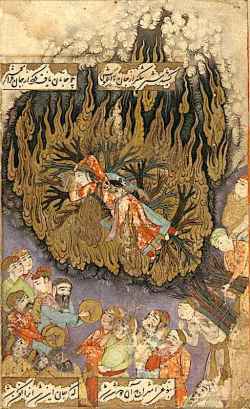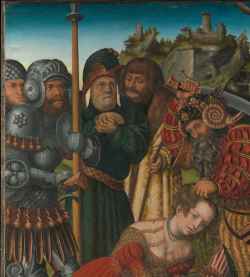Keyword: Gender
Neoptolemus sacrificing Polyxena at Achilles's tomb (1539)
from: Ovid, Metamorphoses, Paris 1539 (Denys Janot), Vol. 3, p. 150
Sacrificial Slaughter and Dressing Up: Gender Articulations in Muslim Rituals
in: Religious Studies News, v. 22 (1996), issue 3: pp.209-13.
War, women, and the state: the politics of sacrifice in the Ottoman Empire during the First World War
in: Journal of Women’s History, v. 26 (2014), issue 3: pp.12-35.
Queen Nzinga sacrifices a man [illustration of Dapper Naukeurige beschrijvinge der Afrikaensche gewesten] (1676)
from: Olfert Dapper, Naukeurige beschrijvinge der Afrikaensche gewesten, Amsterdam, Meurs,1668, p. 238
Satī. The bride immolates herself on the funeral pyre (1657)
from: Isfahan, Iran
The Israel Museum, Jerusalem
What self-immolation means to Afghan women
in: Peace Review, v. 23 (2011), issue 1: pp.45-51.
in: Burning Women Widows, Witches, and Early Modern European Travelers in India, pp.
New York: Palgrave Macmillan, 2003.
Women and Blood Libel: The Legend of Adil Kikinesh of Drohobycz
in: Western Folklore, v. 71 (2012), issue 3-4: pp.279-290.
The Cool Knife. Imagery of Gender, Sexuality, and Moral Education in Kaguru Initiation Ritual
Washington DC: Smithsonian Institution Press, 1997.
Devi Kund Sagar: The Iconography of Satī and Its Absence in Bikaner’s Chatrīs
in: Royal Umbrellas of Stone: Memory, Politics, and Public Identity in Rajput Funerary Art, pp. 213–247
Leiden: Brill, 2015.
Sacrificial Slaughter and Dressing Up: Gender Articulations in Muslim Rituals
in: Religious Studies Review, v. 22 (), issue 3: pp.209-13.
Dying to Be Men: Gender and Language in Early Christian Martyr Texts
New York: Columbia University Press, .
Sacred performances : Islam, sexuality, and sacrifice
New York: Columbia University Press, 1989.
Tales of Sex and Violence: Folklore, Sacrifice, and Danger in the Jaiminīya Brāhmaṇa
Chicago: University if Chicago Press, 1985.
The Legend of Miaoshan
London: Ithaca Press, 1978.
Die flambierte Frau: Sati in European Culture
in: Sati, the Blessing and the Curse: The Burning of Wives in India, pp. 35-50
Oxford: Oxford University Press, 1994.
Sati and the Task of the Historian
in: Journal of World History, v. 18 (2007), issue 3: pp.361-368.
Les Veuves de Malabar: Sati, Colonialism, and the Enlightment
in: French Theatre, Orientalism, and the Representation of India, 1770-1865, pp. 19-71
Abingdon - New York: Routledge, 2021.




